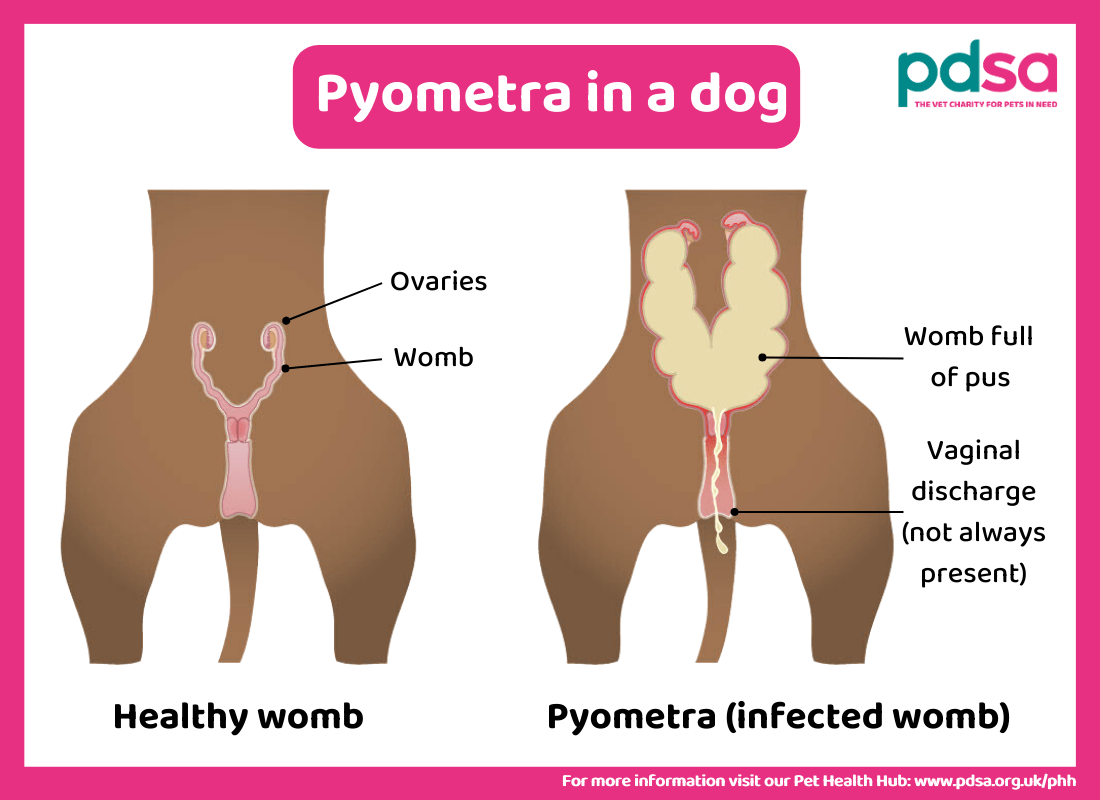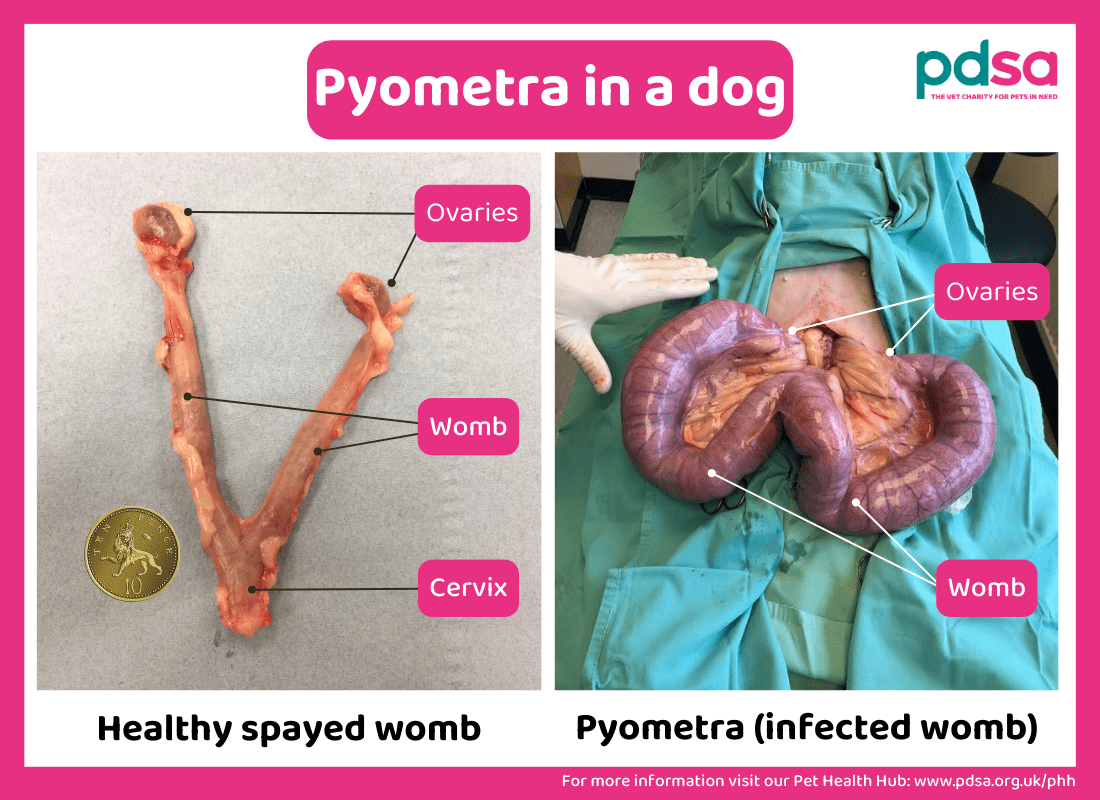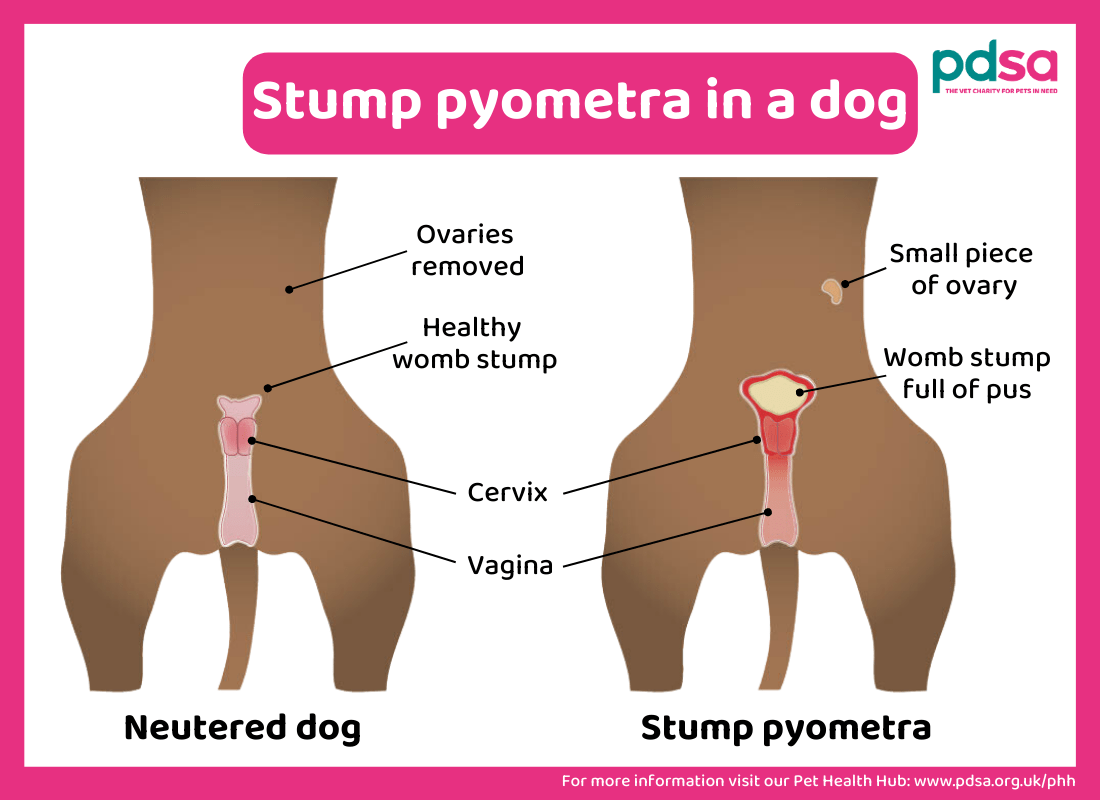Pyometra (infected womb) in dogs
Overview
- A pyometra (or “pyo”) is a womb infection — a very serious condition that’s common in unneutered female dogs.
- Treatment for a pyometra usually includes emergency surgery to remove the womb, a fluid drip, and medication.
- The sooner a dog with a pyometra is treated, the better their chance of survival and recovery. Left untreated, a pyometra can cause death.
- The most common time for a pyometra to develop is four to eight weeks after your dog’s season (heat).
- Neutering your dog will prevent her from developing a pyometra.
- A pyometra is an emergency — contact your vet immediately for an emergency appointment if your dog is showing symptoms.
A pyometra, sometimes called a “pyo”, is an infection inside the uterus (womb). Any unneutered (entire) female dog is at risk of developing a pyometra, and although it can happen at any age, the risk becomes higher once they are over six years old.
During a dog’s season (heat), hormones are released which increase the risk of a bacterial infection developing inside the womb. If an infection does take hold, the womb will fill with pus (pyometra), which tends to cause severe illness. If a pyometra is left untreated, the pus can leak into the abdomen causing peritonitis (infection of the lining of the abdomen), sepsis, dehydration, kidney failure, and even death.
A pyometra can be either ‘open’ or ‘closed’:
- An open pyometra is when the cervix (womb entrance) is open. This type of pyometra tends to be more obvious because you are likely to see blood and pus coming from your dog’s vulva.
- A closed pyometra is when the cervix (womb entrance) is shut. This type of pyometra is particularly dangerous because you are unlikely to see any discharge from your dog’s vulva. This makes it it is less obvious, and means pressure can build up inside the womb, putting it at risk of bursting.

Symptoms
Symptoms of a pyometra usually appear four to eight weeks after a season, and tend to include:
- Pus leaking from vulva/vagina
- Drinking more than usual
- Vomiting
- Bloated abdomen (tummy)
- Lethargy (low energy)
- Not eating properly
- Collapse
Surgery
Most dogs require emergency surgery to remove their infected womb.
A drip
Your dog is likely to need a fluid drip to keep her hydrated, especially if she has been vomiting.
Medicines
Alongside surgery, your dog will need pain relief and may need antibiotics.
Hormone treatment
Hormone for a pyometra is sometimes possible, but only in specific circumstances. Your vet will discuss this with you if it’s an option for your dog. Even if medical treatment is successful, it’s likely that your dog’s pyometra will return again after her next season, so surgery to remove her womb may still be necessary.

Pyometra recovery at home
Your dog might need to stay at the vets for a day or two to help her recover, but once she is home you will need to help care for her.
- Elizabethan (cone) collar — your vet is likely to suggest an Elizabethan (cone) or recovery suit to stop her licking her wound. Make sure they keep it on until your vet says otherwise. Check out our page: How to put a cone collar on your dog.
- Rest — you will need to keep your dog calm and rested to allow her surgery wound to heal, and to prevent her damaging her stitches.
- Medicines — you’ll need to give your dog all her prescribed medicines at the right time and dose and let your vet know if you are struggling – there may be alternatives. You might find our medication timetable helpful.
- Pain monitoring — you will need to monitor your dog’s pain levels and speak to your vet if you are concerned. Signs of severe pain include crying, rapid breathing, growling, protecting the area, and wide pupils.
For more information check out our page: Caring for your dog after surgery.
Prevention
Neutering is the best way to prevent your dog from getting a pyometra, so it’s a good idea to speak to your vet about the best time to neuter her. Before this time, monitor her closely for signs of a pyometra after each season.
When to contact your vet
Contact your vet for an urgent appointment if you notice your dog showing any symptoms of a pyometra. A pyometra is an emergency and your dog has the best chance of survival if they receive prompt treatment. You know your dog best, if you are concerned it’s always best to contact your vet.
Cost
Treatment for a pyometra is expensive s it’s very important to speak openly to your vet about your finances, the cost of treatment, as well as what you think is right for your dog.
Consider insuring your dog as soon as you get her, before any signs of illness start. This will ensure you have all the support you need to care for her.
- How long can my dog live with a pyometra?
- What can I expect after pyometra surgery?
- Can a pyometra be treated with antibiotics?
- Can a dog get a pyometra after being spayed?
- Can male dogs get pyometra?
- Can young dogs get pyometra?
How long can my dog live with a pyometra?
If your dog has a pyometra she will need immediate treatment. Leaving a pyometra without treatment is likely to cause severe illness, suffering and death.
What can I expect after pyometra surgery?
Removing an infected womb is major surgery so your dog will need careful monitoring and lots of support. Once your dog is ready to go home, your vet will advise you how to look after them. You will need to make sure they get plenty of rest, stay calm (no jumping/running/playing), eat, drink, and receive any prescribed medicines. It’s likely that your dog will need to wear an Elizabethan (cone) collar or protective suit to stop them licking at their wound.
Can a pyometra be treated with antibiotics?
Treating a pyometra with medicines alone (antibiotics, hormones and anti-inflammatories) is possible for some dogs in specific circumstances. Your vet will discuss this with you if it’s an option for your dog. Even if medical treatment is successful, it’s likely that your dog’s pyometra will return again after her next season, so surgery to remove her womb may still be necessary.
Can a dog get a pyometra after being spayed?

After neutering, a small part of your dog’s womb remains inside her and (although very rare) it’s possible for an infection to develop inside that stump — called a ‘stump pyometra’.
The symptoms, diagnosis and treatment of a stump pyometra are very similar to a ‘normal’ pyometra. For a stump pyometra to develop, ovary hormones need to be present, which means if your dog develops a stump pyometra, she must also have a small piece of ovary tissue inside her which will need to be removed as part of her treatment. It’s likely that this small piece of ovary was not obvious when she was neutered.
Can male dogs get pyometra?
No, male dog’s don’t have a uterus (womb) so can’t get a pyometra.
Can young dogs get pyometra?
Yes, although pyometras are more common in dog’s over six years old, it’s possible for one to develop at any age.
Published: July 2023
Did you find this page useful?
Tell us more
Please note, our vets and nurses are unable to respond to questions via this form. If you are concerned about your pet’s health, please contact your vet directly.
Thank you for your feedback
Want to hear more about PDSA and get pet care tips from our vet experts?
Sign up to our e-newsletter
Written by vets and vet nurses. This advice is for UK pets only. Illustrations by Samantha Elmhurst.

